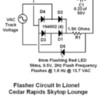As you may have read on the 3-Rail Forum, the Cedar Rapids Skytop Lounge Car of my Olympian Hiawatha took a dive last week, so I have it all apart for repairs. I found the leads to the red flashing LED uninsulated and almost in contact with the metal base of the car. One thing leads to another, so I studied the LED flashing circuit, and here's a diagram I made by interpreting the PCB.
The flashing rate of 1.6 Hz (98 per minute) is really nice on the Cedar Rapids, so I want to make use of this circuit for other projects.






